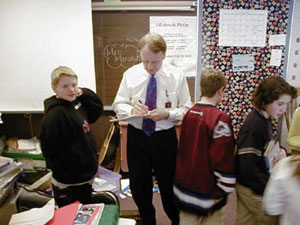No school left untouched
March 10, 2003
 |
| Students in Bob Hainlen's 5th grade class at Edinbrook Elementary School in Brooklyn Park are wrapping up their morning classroom work and getting ready for lunch. (MPR Photo/Tim Pugmire) |
St. Paul, Minn. — Students in Bob Hainlen's 5th grade class at Edinbrook Elementary School in Brooklyn Park are wrapping up their morning classroom work and getting ready for lunch. There are nearly 900 students in kindergarten through sixth grade at the middle-class suburban school, which is located in the Osseo school district. Fifth grader Elizabeth McElligott has attended Edinbrook since kindergarten. "It's a really good school, and everyone here is really nice and stuff," McElligott said. "It's a really good school."
Test scores offer a similarly positive view of Edinbrook. Principal Dan Wald says the school, as a whole, has performed consistently well on standardized tests.
"We've scored above the district, state and national averages throughout the five years that I've been the principal at Edinbrook," Wald said. "So, we work hard. We have ambitious school improvement plans each year, and feel we are working hard to meet the needs of each student."
 | |||
Despite those successes, Wald knows his school could soon land on a list of underachievers. The federal Elementary and Secondary Education Act, also know as "No Child Left Behind," requires all schools and students to make adequate yearly progress toward state standards. Test scores will be broken down into sub-groups, including: disabled, economically disadvantaged, racial or ethnic minority groups and limited English proficiency. Lack of progress in any one group will place a school on the list.
Edinbrook teacher Inger Hanson plays a vocabulary game with students in her English Language Learner class. Her students speak Arabic, Chinese, Hmong, Russian, and Vietnamese at home and have a wide range of academic abilities. Hanson says it's unrealistic to expect all ELL students to perform at their grade level within two or three years.
"Some can do it, but many will fall short of that," Hanson said. "And then the community will look at the ELL program and these children as the ones that are pulling it down."
 | |||
Edinbrook won't be alone. Osseo Superintendent Chris Richardson says he expects half of the district's 19 elementary schools and at least one junior high to be on the "needs improvement" list within two years.
"I think it will cause a lot of consternation, a lot of concern, by parents about what's going on in this building and what does it mean?," said Richardson.
What it means for the six Osseo schools that receive federal money for low income students, known as Title I funds, is a series of corrective actions aimed at improving student achievement. After two years on the list, schools must allow parents to move their children to higher performing schools in the district. Tutors are required in year three. Persistently failing schools could ultimately face state takeovers. Edinbrook is not a Title I school, but it could still wind up on the list. Richardson says that alone will have a big negative impact.
 | |||
"We have a serious morale problem for staff, because we'll have unrealistic goals they can't meet," Richardson said. "We have a serious issue in terms of public confidence, because suddenly we're naming schools that no one was thinking were having any struggle as needs improvement."
The identification of underperforming schools is not new. The previous version of the Elementary and Secondary Education Act required states to list Title I schools with low test scores and provide them additional help. Minnesota's list included 59 schools last year. All but 12 were in Minneapolis or St. Paul. State education officials removed 17 schools from the list last year due to improved performance.
Bryn Mawr elementary in Minneapolis worked its way off the list by improving test scores on the third grade Minnesota Comprehensive Assessment in reading. Teacher Leslie Ferster is working with her 23 third grade students, who'll take the test this spring, on finding the main idea and supporting details in a story. Mina Krenz is already ahead of her classmates on the assignment.
 | |||
"We're working on the molasses flood," Krenz said. "And there's three books that we can choose from for disasters. And we can write about them on this piece of paper and draw a picture."
Teachers at Bryn Mawr say they rallied together to raise student test scores. Leslie Ferster says she's part of a dedicated teaching staff that didn't appreciate the "underachieving" label.
"It can be demoralizing," Ferster said. "When we all work really hard and we know that we really have high standards for our kids, and then to just kind of have this label put on us, that you're not making it."
Bryn Mawr Principal Barbara Braaten says her school focused its energy on improving reading skills. She says staff provided more individual instruction to students who'd fallen behind and those learning to speak English. Four out of ten students at the school are non-English speakers. The old version of the list was based on schools' average test scores. The new one will include the scores of all sub groups. Braaten says it will be difficult to avoid the label of underperforming school.
 | |||
"If you have a small number of students of any ethnic background or any language background or any disability background, or if you have a particular behavior or climate in your school, all those things can tip the balance," Braaten said. "Just one of them has to go a little bit out of balance, and you will be back on the list."
State and federal officials say the reporting of test information under No Child Left Behind is intended to help close the achievement gap between students of different groups. African American students, for example, should perform as well as their white classmates.
State Education Commissioner Cheri Pierson Yecke says many schools are already working hard to close their achievement gaps, but others are not. She says breaking down the test data will focus attention on forgotten children.
"Often times poor performance by certain groups are really masked and hidden when you only report school level assessment data," Yecke said. "Under No Child Left Behind, these other layers are going to be revealed."
Many educators remain troubled, however, by the law's requirement that all students must perform at a proficient level under their state standards within 12 years. And all students means all students.
Mark Davison, director of the University of Minnesota' s Office of Educational Accountability, says he doesn't expect schools to meet such a difficult standard.
"You know this idea of all kids proficient, 100 percent of the kids taking the regular assessments, that's kind of an unforgiving standard," Davison said. "It allows no room for error. And schools are like any institution. They're not as successful as they'd like to be with every child."
Davison says most Minnesota schools will be considered as underperforming, unless Congress adjusts the federal law, or state officials lower their test score bar. Minnesota must submit its final compliance plan to the U.S. Deaprtment of Education by May 1.
|
News Headlines
|
Related Subjects
|

